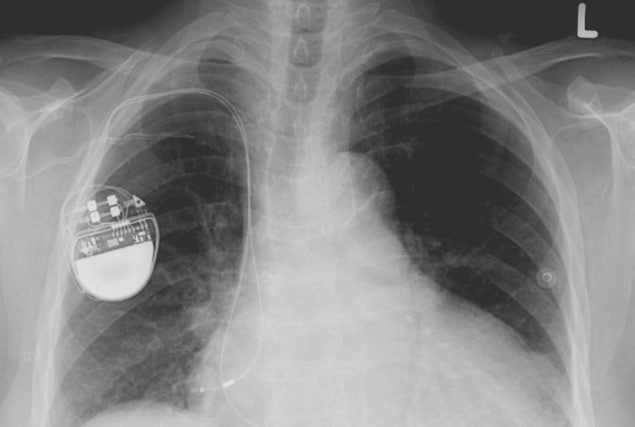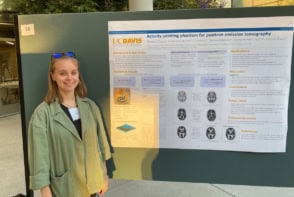
When a patient with a pacemaker or other type of cardiac implantable electronic device (CIED) requires radiotherapy, the treatment plan is designed to avoid direct irradiation of the device, to prevent malfunctioning or even permanent damage. However, temporary direct irradiation of a CIED can occur unintentionally due to sudden patient movement during treatment.
The impact of radiation dose rates of 8 Gy/min or less on the functioning of CIEDs has been thoroughly investigated in prior research. But stereotactic radiotherapy treatments of tumours in the head-and-neck, cervical spine and lung can deliver higher dose rates – to targets that are in close proximity to CIEDs. As such, researchers from Japan have tested the impact of higher dose rates, of up to 24 Gy/min, on four implantable devices. They found that all malfunctioned temporarily when exposed to dose rates greater than 8 Gy/min.
Implantable cardiac pacemakers continuously sense the intervals of cardiac rhythm. They emit electrical pulses to prompt the normal heart rate, or pace, when programmed limits of intervals are exceeded. Another type of CIED, implantable cardioverter-defibrillators (ICDs), also monitor cardiac rhythm, but deliver a high-voltage shock to the heart when needed to stop the abnormal rhythm.
Both of these CIEDs have a battery-powered pulse generator and encased electronics consisting of a semiconductor element and a control circuit. When the control circuit is exposed to radiation, it can cause overcurrent, recognized as false cardiac activity. This may then cause pacing inhibition in patients with pacemakers, or inappropriate shock in patients with defibrillators, causing palpitations, loss of consciousness and/or dizziness.
Lead author Kazuhiko Nakamura, of the Aichi Medical University Hospital, and colleagues tested two pacemakers and two cardiac resynchronization therapy devices. Each was placed on a 20-cm stack of tissue-equivalent phantoms on a treatment couch top, in the centre of a radiation field. Each device was irradiated at dose rates of between 4 and 14 Gy/min with a 6 MV flattening filter-free (FFF) beam, and between 4 and 24 Gy/min with a 10 MV FFF beam. During each irradiation, the team evaluated CIED function using an electrocardiogram.
Transient malfunctions caused by CIED irradiation have different effects depending upon the patient’s CIED dependency. The researchers performed pacing inhibition tests to determine the effects of transient malfunctions in patients with high CIED dependency. They report that for 6 MV beams, pacing inhibition occurred during irradiation in three of four devices at dose rates of 4–12 Gy/min, and in all four at 14 Gy/min. For 10 MV beams, dose rates of 8–24 Gy/min impacted all four CIEDs, and 4 Gy/min affected all but one.
For low CIED dependency patients, the team evaluated the occurrence of asynchronous pacing, the presence of pacing pulses unrelated to those of the device. With 6 MV irradiation, they observed asynchronous pacing in one of the CIEDs at dose rates of 4–8 Gy/min, and in all four at 10 Gy/min or greater. For 10 MV beams, two CIEDS exhibited asynchronous pacing with dose rates of 4–24 Gy/min.
Each CIED malfunctioned under different conditions, and the authors caution that other CIED models might be affected differently. All malfunctions in the four CIEDs tested were transient and reversible, returning to normal function when the irradiation was stopped. No device had permanent damage, and none had significant malfunctions requiring a power-on reset or loss of pacing, even at dose rates of 24 Gy/min.
The authors believe that CIED malfunction has a low impact on patients, and that the risk of irradiation is low because patients’ positions are constantly monitored during radiotherapy, enabling irradiation to be halted immediately if abnormal movement is detected. They caution, however, that clinicians administering radiotherapy should be aware of the risk of malfunction from direct exposure of the CIEDs to X-ray dose rates greater than 8 Gy/min, and should closely monitor and manage patient movement.
This study is described in the Journal of Radiation Research.



